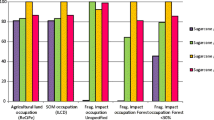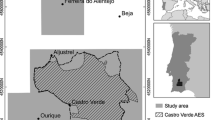Abstract
Cattle move to access patches that vary in forage quantity and quality. Fragmentation can prevent animals from reaching patches. I used an integrative ecosystem model applied to three African landscapes to explore the sensitivity of cattle populations to fragmentation (here, changes in populations as parcel areas decreased) under different precipitation patterns. I hypothesized that low and high precipitation would yield populations relatively insensitive to fragmentation, intermediate precipitation would yield more sensitive populations, and more variable inter-annual precipitation would reduce sensitivity to fragmentation. Precipitation data were altered to yield averages of 100–1,000 mm year−1 and inter-annual coefficients of variation of 0–60%. A 1,000 km2 landscape in each area was divided into progressively smaller parcels and simulations conducted for each parcel. Rainfall at 100 mm year−1 supported low populations that were insensitive to fragmentation. Populations peaked at rainfall levels similar to those observed, and declined under higher precipitation, due in-part to shrub expansion. Fragmenting landscapes caused up to a 62% decline in cattle. High inter-annual variation in precipitation reduced sensitivity to fragmentation when precipitation was above that observed. The pattern was opposite when precipitation was below what was observed. Cattle on the landscape with fine-scale heterogeneity were relatively insensitive to fragmentation, and those on the heterogeneous but coarse-grained landscape were extremely sensitive. Fragmentation in landscapes where populations are sensitive will require more intensive inputs to offset losses, and changes in the frequency of extreme weather associated with climate change will alter the sensitivity of some populations to fragmentation.







Similar content being viewed by others
References
Andren H (1994) Effects of habitat fragmentation on birds and mammals in landscapes with different proportions of suitable habitat: a review. Oikos 71:355–366
Ash AJ, Stafford Smith DM (1996) Evaluating stocking rate impacts in rangelands: animals don’t practice what we preach. Range J 18:216–243
Ash A, Gross J, Stafford-Smith M (2004) Scale, heterogeneity and secondary production in tropical rangelands. Afr J Range Forage Sci 21:137–145
Bekure S, de Leeuw PN, Grandin BE, Neate PJH (eds) (1991) Maasai herding: analysis of the livestock production system of Maasai Pastoralists in eastern Kajiado District, Kenya. Addis Ababa, Ethiopia: ILCA (International Livestock Centre for Africa), ILCA Systems Study 4
Boone RB (2000) Integrated management and assessment system training manual. Manual for IMAS, Global Livestock Collaborative Research Support Program, US Agency for International Development, University of California, Davis
Boone RB (2005) Quantifying changes in vegetation in shrinking grazing areas. Conserv Soc 3:150–173
Boone RB, Hobbs NT (2004) Lines around fragments: effects of fragmentation on large herbivores. Afr J Range Forage Sci 21:79–90
Boone RB, Wang G (2007) Cattle dynamics in African grazing systems under variable climate. J Arid Environ 70:495–513
Boone RB, Coughenour MB, Galvin KA, Ellis JE (2002) Addressing management questions for Ngorongoro Conservation Area using the Savanna Modeling System. Afr J Ecol 40:138–150
Boone RB, Galvin KA, Coughenour MB, Hudson JW, Weisberg PJ, Vogel CH, Ellis JE (2004) Ecosystem modeling adds value to a South African climate forecast. Clim Change 64:317–340
Boone RB, BurnSilver SB, Thornton PK, Worden JS, Galvin KA (2005) Quantifying declines in livestock due to land subdivision in Kajiado District, Kenya. Range Ecol Manage 58:523–532
Boone RB, Galvin KA, Thornton PK, Swift DM, Coughenour MB (2006) Cultivation and conservation in Ngorongoro Conservation Area, Tanzania. Hum Ecol 34:809–828
Boone RB, BurnSilver SB, Worden JS, Galvin KA, Hobbs NT (in press) Large-scale movements of large herbivores: livestock following changes in seasonal forage supply. In: van Langeveld F, Prins HHT (eds) Resource ecology. Kluwer Publishing, Dordrecht
Coe MJ, Cumming DH, Phillipson J (1976) Biomass and production of large African herbivores in relation to rainfall and primary production. Oecol 22:341–354
Conrad V (1941) The variability of precipitation. Month Weather Rev 69:5–11
Coughenour MB (1985) Graminoid responses to grazing by large herbivores: adaptations, exaptations, and interacting processes. Ann MO Bot Gard 72:852–863
Coughenour MB (1992) Spatial modelling and landscape characterization of an African pastoral ecosystem: a prototype model and its potential use for monitoring drought. In: McKenzie DH, Hyatt DE, McDonald VJ (eds) Ecological indicators, vol. 1. Elsevier Applied Science, New York, pp 787–810
Cushman SA (2006) Effects of habitat loss and fragmentation on amphibians: a review and prospectus. Biol Conserv 128:231–240
Davis SA, Pech RP, Catchpole EA (2002) Populations in variable environments: the effect of variability in a species’ primary resource. Philos Trans R Soc Lond B 357:1249–1257
Doncaster CP (2001) Healthy wrinkles for population dynamics: unevenly spread resources can support more users. J Anim Ecol 70:91–100
East R (1984) Rainfall, soil nutrient status and biomass of large African savanna mammals. Afr J Ecol 22:245–270
Easterling DR, Evans JL, Groisman PY, Karl YR, Kunkel KE, Ambenje P (2000) Observed variability and trends in extreme climate events: a brief review. Bull Am Met Soc 81:417–425
Eastman JL, Coughenour MB, Pielke RA Sr (2001) The regional effects of CO2 and landscape change using a coupled plant and meteorological model. Global Change Biol 7:797–815
Ellis J, Coughenour MB (1998) The Savanna integrated modelling system. In: Squires V, Sidahmed A (eds) Drylands: sustainable use of rangelands in the twenty-first century. IFAD technical reports, Rome, pp 97–106
Ellis J, Galvin KA (1994) Climate patterns and land-use practices in the dry zones of Africa. Bioscience 44:340–349
Ellis JE, Swift DM (1988) Stability of African pastoral ecosystems: alternate paradigms and implications for development. J Range Manage 41:450–459
Ellis JE, Coughenour MB, Swift DM (1993) Climate variability, ecosystem stability, and the implications for range and livestock development. Rethinking range ecology: implications for rangeland management in Africa. In: Behnke RH, Scoones I, Kerven C (eds) Range ecology at disequilibrium: new models of natural variability and pastoral adaptation in African savannas. Overseas Development Institute, London
Ewers RM, Didham RK (2005) Confounding factors in the detection of species responses to habitat fragmentation. Biol Rev 81:147–142
Fahrig L (2003) Effects of habitat fragmentation on biodiversity. Ann Rev Ecol Evol Syst 34:487–515
FAO (Food, Agriculture Organization of the United Nations) (2001) Pastoralism in the new millennium. FAO, Rome
Forman RTT (1995) Land mosaics. Cambridge University Press, Cambridge
Galvin KA, Thornton PK, Boone RB, Sunderland J (2004) Climate variability and impacts on East African livestock herders: the Maasai of Ngorongoro Conservation Area, Tanzania. Afr J Range Forage Sci 21:183–189
Galvin KA, Thornton PK, de Pinho JR, Sunderland J, Boone RB (2006) Integrated modeling and its potential for resolving conflicts between conservation and people in the rangelands of East Africa. Hum Ecol 34:155–183
James CD, Landsberg J, Morton SR (1999) Provision of watering points in the Australian arid zone: a review of effects on biota. J Arid Env 41:87–121
Lange RT (1985) Spatial distributions of stocking intensity produced by sheep flocks grazing Australian chenopod shrublands. Trans R Soc South Australia 109:167–174
Lewontin RC, Cohen D (1969) On population growth in a randomly varying environment. Proc Natl Acad Sci USA 62:1056–1060
Ludwig JA, Coughenour MB, Liedloff AC, Dyer R (2001) Modelling the resilience of Australian savanna systems to grazing impacts. Environ Int 27:167–172
Mason SJ, Waylen PR, Mimmack GM, Rajaratnam B, Harrison JM (1999) Changes in extreme rainfall events in South Africa. Clim Change 41:249–257
McCabe JT (1995) Wildebeest/Maasai interactions in the Ngorongoro Conservation Area of Tanzania. Final report (Grant No. 4953-93) submitted to the National Geographic Society, Washington
Mduma SAR, Sinclair ARE, Hilborn R (1999). Food regulates the Serengeti wildebeest: a 40-year record. J Anim Ecol 68:1101–1122
Niamir-Fuller M, Turner MD (1999) A review of recent literature on pastoralism and transhumance in Africa. In: Niamir-Fuller N (ed) Managing mobility in African rangelands: the legitimization of transhumance. Intermediate Technology Publications Ltd, London
Nicholson SE (1980) The nature of rainfall fluctuations in sub-tropical West Africa. Month Weather Rev 108:473–487
Phillipson J (1975) Rainfall, primary production and ‘carrying capacity’ of Tsavo National Park (East), Kenya. East Afr Wildl J 13:171–201
Ritchie M, Olff H (1999) Spatial scaling laws yield a synthetic theory of biodiversity. Nature 400:557–560
Saunders DA., Hobbs RJ, Margules CR (1991) Biological consequences of ecosystem fragmentation: a review. Cons Biol 5:18–32
Thornton PK, Galvin KA, Boone RB (2003) An agro-pastoral household model for the rangelands of East Africa. Agric Syst 76:601–622
Thornton PK, Fawcett RH, Galvin KA, Boone RB, Hudson JW, Vogel CH (2004) Evaluating management options that use climate forecasts: modeling livestock production systems in the semi-arid zone of South Africa. Clim Res 26:33–42
Thornton PK, BurnSilver SB, Boone RB, Galvin KA (2006) Modelling the impacts of group ranch subdivision on agro-pastoral households in Kajiado, Kenya. Agric Syst 87:331–356
Acknowledgments
This research was supported by the US National Science Foundation Biocomplexity program under grant number 0119618 to N.T. Hobbs et al., known as the SCALE project. Discussions with SCALE project personnel improved the manuscript, and comments from two anonymous reviewers and the Editor were helpful.
Author information
Authors and Affiliations
Corresponding author
Electronic supplementary material
Below is the link to the electronic supplementary material.
Rights and permissions
About this article
Cite this article
Boone, R.B. Effects of fragmentation on cattle in African savannas under variable precipitation. Landscape Ecol 22, 1355–1369 (2007). https://doi.org/10.1007/s10980-007-9124-4
Received:
Accepted:
Published:
Issue Date:
DOI: https://doi.org/10.1007/s10980-007-9124-4




